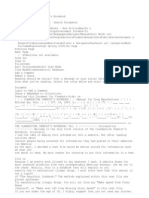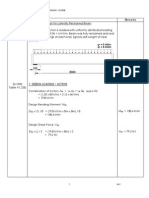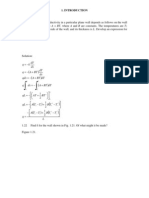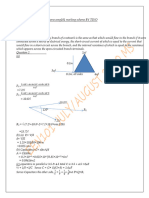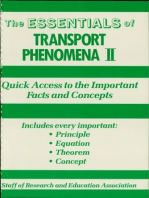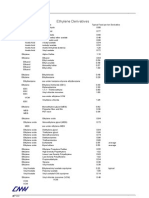Comparison TDDB Models
Uploaded by
Thomas W KotowskiComparison TDDB Models
Uploaded by
Thomas W KotowskiDEFECT RELATED BREAKDOWN MODEL (Oxide thinning = Xox): Xeffective = tox - Xox .
V
oxPos
V
gate
0.2 := V
oxNeg
V
gate
1.3 :=
o
10
11
sec := B 240 10
6
volt
cm
:= G
o
320 10
6
volt
cm
:= tbd
Lee
V ( )
o
exp
G
o
X
eff
V volt
|
\
|
|
:=
J
FN
V ( ) 3 10
8
exp
B X
eff
V volt
\
|
|
amp
cm
2
:= J
FN
7.9 ( ) tbd
Lee
7.9 ( ) 8.943
coul
cm
2
= Qbd 10
coul
cm
2
:=
c 0.7 := slope
70
c
ln
3 10
1
4 10
5
\
|
|
|
:=
TWK Approx for Defect Density, D(X)
tox = 107A, A = 500 x 500 um
D Xox
( )
4 10
5
exp
Xox
c
slope
|
\
|
|
:=
a1 13.1 := a2 6.3 :=
b1 0.26 := b2 0.175 := Df Xox
( )
a1 exp b1 Xox
( )
a2 exp b2 Xox
( )
+
( )
10
4
:=
Note: Article says b2 = -0.11. Added 10^4 above. This is a bi-Poisson Defect Distribution. See Yugami 1994
For a fixed Vox, the distribution D(X) of X can be
extracted from the tbd distribution, i.e. X =X(tbd).
X tbd ( ) t
ox
V
ox
G
o
ln
tbd sec
o
|
\
|
|
:=
COMPARISON AND EVOLUTION OF GATE OXIDE TBD MODELS
http://www.leapcad.com/Other_Tech/Comparison_TDDB_Models.MCD
PHYSICAL CONSTANTS: k 8.62 10
5
ev := ev 1.6 10
19
joule q 1.6 10
19
coul :=
DEVICE DATA: thick
SiO2
600 A := X
eff
79 A := t
ox
107 A := V
gate
1 :=
VARIABLES: Tk 300 400 .. := V 5 60 .. := Xox 1 70 .. := V
ox
11.2 volt :=
1985, K. Yamabe, "Time dependent dielectric breakdown ... SiO2 films", SC 20, pg. 343:
TBD has a Thickness dependent Field Acceleration Factor, = = = =d(log(tbd)/dEox
Tox ( ) 4.2 log Tox ( ) 6.95 ( )
cm
MV
:= 200 ( ) 2.714
cm
MV
=
The time to fail for 200A oxide is shortened by 10^ -2.7 with an increase of the stress field by 1MV/cm.
1988, Qp Model, J. Lee, "Modeling and Char of Gate Oxide Relibility", ED 35, pg. 2268:
INTRINSIC BREAKDOWN MODEL, Critical Hole Fluence, Qp:
Oxide lifetime is is the time required for the hole fluence Qp, to reach a critical value.
Qp ~ J t, where J is the FN current ~ e(-B/Eox) and is the hole generation coefficient
~ e(-H/Eox). Then Qp ~ e(-G/Eox) t, where G = B + H.
The Temperature Variation is modeled the same as R. Moazzami, which follows.
1
.
10
5
1
.
10
4
1
.
10
3
0.01 0.1 1 10 100
1
10
100
1
.
10
3
1
.
10
4
1
.
10
5
1
.
10
6
1/ Fail Rate vs time
Fig. 11a. Time (sec)
1
/
F
a
i
l
R
a
t
e
(
%
p
e
r
s
e
c
)
tbd
i
4 , ( )
tbd
i
0.25 , ( )
tbd
i
0.01 , ( )
tbd
i
1
.
10
5
1
.
10
4
1
.
10
3
0.01 0.1 1 10
0.01
0.1
1
10
100
Cumulative % Fail vs time
Fig. 10a. Time (sec)
C
u
m
%
F
a
i
l
u
r
e
CumFail tbd
i
4 , ( )
CumFail tbd
i
0.25 , ( )
CumFail tbd
i
0.01 , ( )
tbd
i
Area: 4, 0.25, 0.01 mm^2, Xox = 107A, Vgate = 11V
0 10 20 30 40 50 60 70
0.1
1
10
100
1
.
10
3
1
.
10
4
1
.
10
5
1
.
10
6
Defect Density as a function of delta X
Fig 9. Oxide Thinning (A) for 107A Gate
A
r
e
a
D
e
n
s
i
t
y
(
1
/
c
m
^
2
)
D Xox ( )
Df Xox ( )
Xox
6 8 10 12 14 16 18
1
.
10
4
1
.
10
3
0.01
0.1
1
10
100
1
.
10
3
1
.
10
4
1
.
10
5
1
.
10
6
Time to Failure (sec)
Fig. 1. 79A Gate
tbd
Lee
V ( )
sec
V
tbd Area , ( )
Area
V
ox
tbd G
o
1
Area mm
2
cm
2
Df X tbd ( ) A
1
|
\
|
+
a1 b1 exp b1
X tbd ( )
A
\
|
|
a2 b2 exp b2
X tbd ( )
A
\
|
|
+
|
\
|
|
10
4
A
:=
Note: Added - sign to Area
Assume the defect distribution is
clustered, i.e. gamma distribution
with cluster factor, s = 0.6.
CumFail tbd Area , ( ) 100 1
1
1
Area mm
2
cm
2
D X tbd ( ) A
1
|
\
|
s +
|
\
|
|
|
1
s
(
(
(
(
(
(
:=
s 0.6 := tbd
i
tbmin e
i
r
n
:= i 1 n .. := r ln
tbmax
tbmin
|
\
|
|
:= n 200 := tbmax 1000 := tbmin 10
5
:=
PREDICTING RELIABILITY FROM GAMMA DEFECT DISTRIBUTION:
30 35 40 45 50 55 60
0.5
0.55
0.6
0.65
0.7
0.75
0.8
Reduction of Activation Energy vs. Field
Fig. 3.
Q V ( )
V
tbd
.McP
V T , ( ) Ao e
Q V ( ) ev
k T
:= Time to 50% Failure, TF: Q V ( )
Ho 7.2 q A V
volt
thick
SiO2
ev
:=
Ao 1 sec := Ho 1.15 ev := Enthalpy of Activation for Si-Si Breakage: Ho
Warranty 2000 hr = 7.2M sec. For 0.1ppm Failures,
need factor of 0.5/0.0000001 ==> t
50
of 1.4 E14 sec.
1997, J. W. McPhearson, "Field enhanced Si-Si bond breakage", AP Phys Let, Aug, p.1101
Low Field TBD data reveals that TBD had field dependence ~ E and not 1/E.
1 10 100 1
.
10
3
10
100
Poisson Cum % Fail vs time for D(Xeff)
Scale Time
C
u
m
%
F
a
i
l
u
r
e
CF tbd
i
0.2 , ( )
tbd
i
RELIABILITY PROJECTION, CUMULATIVE FAILURE PROBABILITY, CF:
Assume that defects are distributed randomly across the wafer. Poisson Distribution.
CF tbd Area , ( ) 100 1 exp
Area mm
2
cm
2
D X tbd ( ) A
1
|
\
|
\
|
|
|
\
|
|
|
:= X tbd ( ) X
eff
V
ox
G
o
ln
tbd sec
o
|
\
|
|
:=
tbd
Mz
V T , ( ) T ( )
o
exp
G T ( ) X
eff
V volt
|
\
|
|
:= T ( ) exp
E
b
k
1
T
1
300
\
|
|
(
(
:= G T ( ) Go 1
k
1
T
1
300
\
|
|
(
(
:=
Go 300 10
6
volt
cm
:= X
eff
100 A := E
b
0.28 ev := 0.0167 ev :=
o
10
11
sec :=
V
ox
8 volt :=
Temp Variation on Qbd/Qp Model:
.
1990, R. Moazzami, "Projecting Gate Oxide Rel", ED 37, pg 1643):
0.8 0.9 1 1.1 1.2 1.3 1.4 1.5 1.6
1
10
100
1
.
10
3
1
.
10
4
1
.
10
5
1
.
10
6
Median Time to Failure x Eox^2 vs. 1/Eox
Fig. 4 1/Eox (10^-7 cm/V)
tbd
Shi
Vi InvE ( ) 423 , ( )
Vi InvE ( )
t
ox
|
\
|
|
hr
MV
cm
|
\
|
|
InvE
CF h MTF , ( ) 1 exp
h
MTF ( )
|
\
|
|
mp
(
(
:=
MTF ( )
MTF
ln 2 ( )
1
mp
:=
h
i
hmin e
i
r
n
:=
r ln
hmax
hmin
|
\
|
|
:= i 1 n .. := n 200 := hmax 2 10
4
:= hmin 1 :=
Vi InvE ( ) t
ox
InvE 10
7
cm
volt
\
|
|
1
volt
1
:= InvE 0.8 0.82 , 1.54 .. :=
Plot Inverse of
E = 1/Eox:
mn 3 :=
tbd
Shi
V T , ( ) os exp
EaPlus
k T
|
\
|
|
exp G
sp
t
ox
V volt
\
|
|
V volt
t
ox
|
\
|
|
S
Area
|
\
|
|
1
mp
:=
G
sn
125 :=
EaMinus 0.56 ev :=
Area 0.09 mm
2
:= S 0.01 mm
2
:= os 1 hr
volt
cm
|
\
|
|
2
:= t
ox
110 A := G
sp
150
MV
cm
:= EaPlus 0.63 ev :=
mp 4 :=
1993, N. Shiono, "A lifetime projection method using series ...TDDB...", IRPS, p. 1
!/E overestimates low field lifetime. log(MTF Eox2) vs. !/Eox fits low fields.
Use full FN, J
FN
= A. E
ox
2
exp(-B/E
ox
), then MTF ~ exp(G/E
ox
)/E
ox
2
. Note os Differences
MODEL FOR TDDB STATISTICS: The Weibull is the extreme distribution for minimum value. TDDB
breakdown is min value. Therefore the Weibull is a more suitable statistical distribution model than log
normal. DMOS is composed of many cells, the failure of any one causes device failure. This is a series
model. Normalized Cumulative Failure CF(t) = 1- exp(-(t/)
m
), = i/(
1/m
) is the characteristic
lifetime, m is the dispersion of lifetime, and n is the number of elements which is proportional to Area. Then
MTF~ Area
1/m
Let m
p
= and = .
0.1 1 10 100 1
.
10
3
1
.
10
4
1
.
10
5
1
10
100
TDDB Failure Distribution (Cum %)
Fig. 2b Aging Time (hours)
C
u
m
u
l
a
t
i
v
e
F
a
i
l
u
e
s
(
%
)
CumFail tbd 4 , ( )
100 CF h
i
2 , ( )
100 CF h
i
20 , ( )
100 CF h
i
50 , ( )
100 CF h
i
5 10
2
, ( )
100 CF h
i
10
4
, ( )
h
i
i
1 :=
i
n
1
mp
:=
LLCF h MTF , ( ) ln ln 1 CF h MTF , ( ) ( )
1
:=
FAILURE RATE PROJECTIONS:
Shiono's definition of acceptable failure rate Spec (FIT)
Failure Rate, (t): t MTF , ( )
mp
MTF ( )
mp
t
mp 1
:=
FailSpec 0.001 :=
oss 1.9 10
12
hr
MV
cm
|
\
|
|
2
:= tbd
ShiE
E T , ( ) oss exp
EaPlus
k T
|
\
|
|
exp G
sp
cm
E MV
\
|
|
E
MV
cm
\
|
|
S
Area
|
\
|
|
1
mp
:=
E
t E , ( )
mp
tbd
ShiE
E 358 , ( )
hr
|
\
|
|
mp
t
mp 1
:=
t25yr 25 365 24 := E 3 3.1 , 6 .. :=
Ta = 85C, Area = 10 mm
2
3 3.5 4 4.5 5 5.5 6
1
.
10
12
1
.
10
11
1
.
10
10
1
.
10
9
1
.
10
8
1
.
10
7
1
.
10
6
1
.
10
5
1
.
10
4
1
.
10
3
0.01
0.1
Projected Failure Rate @25 Years
Fig 11. Eox (MV/cm)
F
I
T
s
E
t25yr E , ( )
10
9
FailSpec
E
300 320 340 360 380 400
1
.
10
6
1
.
10
5
1
.
10
4
1
.
10
3
0.01
0.1
1
10
100
1
.
10
3
1
.
10
4
Median Time to Failure vs. Temp
Temperature Dependence
tbd
Mz
40 Tk , ( )
yr
tbd
Shi
40 Tk , ( )
yr
tbd
McP
40 Tk , ( )
yr
TF
IRF
40 Tk , ( )
TenYears
WarrantyMiles
yr
Tk
10 15 20 25 30 35 40 45 50 55 60
0.01
0.1
1
10
100
1
.
10
3
1
.
10
4
Median Time to Failure @150C
Field Dependence
tbd
Mz
V 423 , ( )
yr
tbd
Shi
V 423 , ( )
yr
tbd
McP
V 423 , ( )
yr
TF
IRF
V 423 , ( )
TenYears
UseFullLife
yr
WarrantyMiles
yr
V
tbd
McP
V T , ( ) Ao e
Q V ( ) ev
k T
0.02 := tbd
Mz
V T , ( ) T ( )
o
exp
G T ( ) thick
SiO2
V volt
|
\
|
|
:=
tbd
Shi
V T , ( ) os exp
EaPlus
k T
|
\
|
|
exp G
sp
thick
SiO2
V volt
\
|
|
V volt
thick
SiO2
|
\
|
|
S
M7
|
\
|
|
1
mp
:=
M7 1300 mil
2
:=
TF
IRF
V T , ( ) 7 10
28
e
V volt
G
accel
thick
SiO2
sec
yr T ( )
:= G
accel
0.112
MV
cm
:=
Projected LOG NORMAL Plot
for Median Time to Fail vs.Vgate
from Power DMOS Data Sheet.
Gate oxide thickness unknown.
UseFullLife 1.141yr = UseFullLife
UseFullLifeMiles
20 mi hr
1
:= UseFullLifeMiles 2 10
5
mi :=
WarrantyMiles 0.228yr = WarrantyMiles 50000
mi hr
25 mi
:= TenYears 10 :=
AF T ( ) exp
0.4 ev
k
1
T
1
423
\
|
|
(
(
:=
COMPARISON OF E AND 1/E MODELS
X T ( )
exp
E
b
k
1
T
1
300
\
|
|
(
(
1
exp
E
b
k
1
T
1
300
\
|
|
(
(
(
(
(
:=
300 320 340 360 380 400
0
2
4
6
8
10
12
14
Tk ( )
X Tk ( )
Tk
A 10
8
cm MV 10
6
volt mil 10
3
in
You might also like
- Scientific Details of The Linen Frequency Study92% (13)Scientific Details of The Linen Frequency Study5 pages
- Seventy-Eight Degrees of Wisdom - A Book of Tarot, Revised - Rachel Pollack100% (40)Seventy-Eight Degrees of Wisdom - A Book of Tarot, Revised - Rachel Pollack370 pages
- Essential Oils Desk Reference Sixth Edition OCR SMALL94% (18)Essential Oils Desk Reference Sixth Edition OCR SMALL822 pages
- ResinFundamentalsKatherineSwift Compressed100% (4)ResinFundamentalsKatherineSwift Compressed41 pages
- Average Atomic Mass and Percent Abundance Worksheet 2 and KEY50% (4)Average Atomic Mass and Percent Abundance Worksheet 2 and KEY2 pages
- Introduction To Fluid Mechanics - 6 Ed - Fox - Solution Manual Chapter 157% (7)Introduction To Fluid Mechanics - 6 Ed - Fox - Solution Manual Chapter 147 pages
- Kitchen Improvised Crank - Propylhexedrine100% (11)Kitchen Improvised Crank - Propylhexedrine4 pages
- Exercise 1 (Permeability And Seepage) : i= h S hcosα S100% (1)Exercise 1 (Permeability And Seepage) : i= h S hcosα S11 pages
- Fundamentals - of - Microelectronics (Manual) by Razavi80% (5)Fundamentals - of - Microelectronics (Manual) by Razavi855 pages
- Process Dynamics and Control, Ch. 11 Solution Manual100% (9)Process Dynamics and Control, Ch. 11 Solution Manual29 pages
- Analysis & Simulation of The Trajectory of The Apollo 11 Flight To MoonNo ratings yetAnalysis & Simulation of The Trajectory of The Apollo 11 Flight To Moon57 pages
- Improved Koren Pentode Conductance ModelNo ratings yetImproved Koren Pentode Conductance Model14 pages
- Isolation of Plant Essential Oil Using Steam Distillation Lab ReportNo ratings yetIsolation of Plant Essential Oil Using Steam Distillation Lab Report6 pages
- Chlorine Dioxide: With A Health-Guide For Making & Using Clo2 in The Home100% (10)Chlorine Dioxide: With A Health-Guide For Making & Using Clo2 in The Home90 pages
- Exercise 1: Matrix-Fracture Transfer Estimation in A Transient Well TestNo ratings yetExercise 1: Matrix-Fracture Transfer Estimation in A Transient Well Test10 pages
- Post Task - Cristian Leonardo PiragauraNo ratings yetPost Task - Cristian Leonardo Piragaura11 pages
- Waqar Ahmad_17pwciv4763_A_Structural DynomicsNo ratings yetWaqar Ahmad_17pwciv4763_A_Structural Dynomics13 pages
- The Parachute Problem: Ronald Phoebus and Cole ReillyNo ratings yetThe Parachute Problem: Ronald Phoebus and Cole Reilly23 pages
- Max Kondrath Intro To Global Change 10/6/2010: Lab 4 - Carbon CycleNo ratings yetMax Kondrath Intro To Global Change 10/6/2010: Lab 4 - Carbon Cycle11 pages
- The Frecuency-Response Design Method: Universidad Politecnica SalesianaNo ratings yetThe Frecuency-Response Design Method: Universidad Politecnica Salesiana28 pages
- Jangkar & Kemudi 1710313037 Emiraldy NirvadimahsaNo ratings yetJangkar & Kemudi 1710313037 Emiraldy Nirvadimahsa132 pages
- Analytical Modeling of Solute Transport in Groundwater: Using Models to Understand the Effect of Natural Processes on Contaminant Fate and TransportFrom EverandAnalytical Modeling of Solute Transport in Groundwater: Using Models to Understand the Effect of Natural Processes on Contaminant Fate and TransportNo ratings yet
- Hyrdoacoustic Ocean Exploration: Theories and Experimental ApplicationFrom EverandHyrdoacoustic Ocean Exploration: Theories and Experimental ApplicationNo ratings yet
- 3D Modeling of Nonlinear Wave Phenomena on Shallow Water SurfacesFrom Everand3D Modeling of Nonlinear Wave Phenomena on Shallow Water SurfacesNo ratings yet
- Enhanced Oil Recovery: Resonance Macro- and Micro-Mechanics of Petroleum ReservoirsFrom EverandEnhanced Oil Recovery: Resonance Macro- and Micro-Mechanics of Petroleum Reservoirs5/5 (1)
- Student Solutions Manual to Accompany Economic Dynamics in Discrete Time, secondeditionFrom EverandStudent Solutions Manual to Accompany Economic Dynamics in Discrete Time, secondedition4.5/5 (2)
- Physics and Technology of Crystalline Oxide Semiconductor CAAC-IGZO: Application to DisplaysFrom EverandPhysics and Technology of Crystalline Oxide Semiconductor CAAC-IGZO: Application to DisplaysNo ratings yet
- Logical progression of twelve double binary tables of physical-mathematical elements correlated with scientific-philosophical as well as metaphysical key concepts evidencing the dually four-dimensional basic structure of the universeFrom EverandLogical progression of twelve double binary tables of physical-mathematical elements correlated with scientific-philosophical as well as metaphysical key concepts evidencing the dually four-dimensional basic structure of the universeNo ratings yet
- Numerical Methods for Simulation and Optimization of Piecewise Deterministic Markov Processes: Application to ReliabilityFrom EverandNumerical Methods for Simulation and Optimization of Piecewise Deterministic Markov Processes: Application to ReliabilityNo ratings yet
- Southern Marine Engineering Desk Reference: Second Edition Volume IFrom EverandSouthern Marine Engineering Desk Reference: Second Edition Volume INo ratings yet
- Analysis and Design of Multicell DC/DC Converters Using Vectorized ModelsFrom EverandAnalysis and Design of Multicell DC/DC Converters Using Vectorized ModelsNo ratings yet
- Tunnel Field-effect Transistors (TFET): Modelling and SimulationFrom EverandTunnel Field-effect Transistors (TFET): Modelling and SimulationNo ratings yet
- Analysis and Modeling of The COVID-19 EpidemicNo ratings yetAnalysis and Modeling of The COVID-19 Epidemic47 pages
- Climate Data-Proxies and ReconstructionsNo ratings yetClimate Data-Proxies and Reconstructions54 pages
- Analysis & Simulation of The Trajectory of The Apollo 11 Flight To MoonNo ratings yetAnalysis & Simulation of The Trajectory of The Apollo 11 Flight To Moon56 pages
- Bug Out Bag Encyclopedia Emergency, Disaster, Survival Preparedness (Joseph Yao, MD (Joseph Yao, MD) ) PDF100% (2)Bug Out Bag Encyclopedia Emergency, Disaster, Survival Preparedness (Joseph Yao, MD (Joseph Yao, MD) ) PDF606 pages
- Smudging and Space Cleansing EKit With Pics100% (6)Smudging and Space Cleansing EKit With Pics20 pages
- Home Distillation Handbook - How To Distill Quality Alcohol at Home Inexpensively and SafelyNo ratings yetHome Distillation Handbook - How To Distill Quality Alcohol at Home Inexpensively and Safely95 pages
- Premium 2nd Edition Advanced Dungeons & Dragons Monstrous Manual100% (7)Premium 2nd Edition Advanced Dungeons & Dragons Monstrous Manual385 pages
- Explain Formation of Energy Bands in Solids and Explain Classification On The Basis of Energy Band Theory - PDFNo ratings yetExplain Formation of Energy Bands in Solids and Explain Classification On The Basis of Energy Band Theory - PDF2 pages
- Digital Clock With Hours, Minutes and Seconds + Alarm SystemNo ratings yetDigital Clock With Hours, Minutes and Seconds + Alarm System9 pages
- Comsol - Modeling of Three Dimensional Dye-SensitizedNo ratings yetComsol - Modeling of Three Dimensional Dye-Sensitized6 pages
- Service Manual Service Manual: SKS-HT540 (B)No ratings yetService Manual Service Manual: SKS-HT540 (B)19 pages
- FPGA For Dummies - Part 1 - Historical Introduction PDFNo ratings yetFPGA For Dummies - Part 1 - Historical Introduction PDF15 pages
- Regulated Power Supply Semester PresentationNo ratings yetRegulated Power Supply Semester Presentation14 pages
- NPN Silicon Epitaxial Planar Transistor D882No ratings yetNPN Silicon Epitaxial Planar Transistor D8825 pages
- Seventy-Eight Degrees of Wisdom - A Book of Tarot, Revised - Rachel PollackSeventy-Eight Degrees of Wisdom - A Book of Tarot, Revised - Rachel Pollack
- Essential Oils Desk Reference Sixth Edition OCR SMALLEssential Oils Desk Reference Sixth Edition OCR SMALL
- Average Atomic Mass and Percent Abundance Worksheet 2 and KEYAverage Atomic Mass and Percent Abundance Worksheet 2 and KEY
- Introduction To Fluid Mechanics - 6 Ed - Fox - Solution Manual Chapter 1Introduction To Fluid Mechanics - 6 Ed - Fox - Solution Manual Chapter 1
- Exercise 1 (Permeability And Seepage) : i= h S hcosα SExercise 1 (Permeability And Seepage) : i= h S hcosα S
- Fundamentals - of - Microelectronics (Manual) by RazaviFundamentals - of - Microelectronics (Manual) by Razavi
- Process Dynamics and Control, Ch. 11 Solution ManualProcess Dynamics and Control, Ch. 11 Solution Manual
- Analysis & Simulation of The Trajectory of The Apollo 11 Flight To MoonAnalysis & Simulation of The Trajectory of The Apollo 11 Flight To Moon
- Isolation of Plant Essential Oil Using Steam Distillation Lab ReportIsolation of Plant Essential Oil Using Steam Distillation Lab Report
- Chlorine Dioxide: With A Health-Guide For Making & Using Clo2 in The HomeChlorine Dioxide: With A Health-Guide For Making & Using Clo2 in The Home
- Exercise 1: Matrix-Fracture Transfer Estimation in A Transient Well TestExercise 1: Matrix-Fracture Transfer Estimation in A Transient Well Test
- The Parachute Problem: Ronald Phoebus and Cole ReillyThe Parachute Problem: Ronald Phoebus and Cole Reilly
- Max Kondrath Intro To Global Change 10/6/2010: Lab 4 - Carbon CycleMax Kondrath Intro To Global Change 10/6/2010: Lab 4 - Carbon Cycle
- The Frecuency-Response Design Method: Universidad Politecnica SalesianaThe Frecuency-Response Design Method: Universidad Politecnica Salesiana
- Analytical Modeling of Solute Transport in Groundwater: Using Models to Understand the Effect of Natural Processes on Contaminant Fate and TransportFrom EverandAnalytical Modeling of Solute Transport in Groundwater: Using Models to Understand the Effect of Natural Processes on Contaminant Fate and Transport
- Hyrdoacoustic Ocean Exploration: Theories and Experimental ApplicationFrom EverandHyrdoacoustic Ocean Exploration: Theories and Experimental Application
- 3D Modeling of Nonlinear Wave Phenomena on Shallow Water SurfacesFrom Everand3D Modeling of Nonlinear Wave Phenomena on Shallow Water Surfaces
- Enhanced Oil Recovery: Resonance Macro- and Micro-Mechanics of Petroleum ReservoirsFrom EverandEnhanced Oil Recovery: Resonance Macro- and Micro-Mechanics of Petroleum Reservoirs
- Student Solutions Manual to Accompany Economic Dynamics in Discrete Time, secondeditionFrom EverandStudent Solutions Manual to Accompany Economic Dynamics in Discrete Time, secondedition
- Physics and Technology of Crystalline Oxide Semiconductor CAAC-IGZO: Application to DisplaysFrom EverandPhysics and Technology of Crystalline Oxide Semiconductor CAAC-IGZO: Application to Displays
- Logical progression of twelve double binary tables of physical-mathematical elements correlated with scientific-philosophical as well as metaphysical key concepts evidencing the dually four-dimensional basic structure of the universeFrom EverandLogical progression of twelve double binary tables of physical-mathematical elements correlated with scientific-philosophical as well as metaphysical key concepts evidencing the dually four-dimensional basic structure of the universe
- Numerical Methods for Simulation and Optimization of Piecewise Deterministic Markov Processes: Application to ReliabilityFrom EverandNumerical Methods for Simulation and Optimization of Piecewise Deterministic Markov Processes: Application to Reliability
- Southern Marine Engineering Desk Reference: Second Edition Volume IFrom EverandSouthern Marine Engineering Desk Reference: Second Edition Volume I
- Analysis and Design of Multicell DC/DC Converters Using Vectorized ModelsFrom EverandAnalysis and Design of Multicell DC/DC Converters Using Vectorized Models
- Tunnel Field-effect Transistors (TFET): Modelling and SimulationFrom EverandTunnel Field-effect Transistors (TFET): Modelling and Simulation
- Analysis & Simulation of The Trajectory of The Apollo 11 Flight To MoonAnalysis & Simulation of The Trajectory of The Apollo 11 Flight To Moon
- Bug Out Bag Encyclopedia Emergency, Disaster, Survival Preparedness (Joseph Yao, MD (Joseph Yao, MD) ) PDFBug Out Bag Encyclopedia Emergency, Disaster, Survival Preparedness (Joseph Yao, MD (Joseph Yao, MD) ) PDF
- Home Distillation Handbook - How To Distill Quality Alcohol at Home Inexpensively and SafelyHome Distillation Handbook - How To Distill Quality Alcohol at Home Inexpensively and Safely
- Premium 2nd Edition Advanced Dungeons & Dragons Monstrous ManualPremium 2nd Edition Advanced Dungeons & Dragons Monstrous Manual
- Explain Formation of Energy Bands in Solids and Explain Classification On The Basis of Energy Band Theory - PDFExplain Formation of Energy Bands in Solids and Explain Classification On The Basis of Energy Band Theory - PDF
- Digital Clock With Hours, Minutes and Seconds + Alarm SystemDigital Clock With Hours, Minutes and Seconds + Alarm System
- Comsol - Modeling of Three Dimensional Dye-SensitizedComsol - Modeling of Three Dimensional Dye-Sensitized
- FPGA For Dummies - Part 1 - Historical Introduction PDFFPGA For Dummies - Part 1 - Historical Introduction PDF




